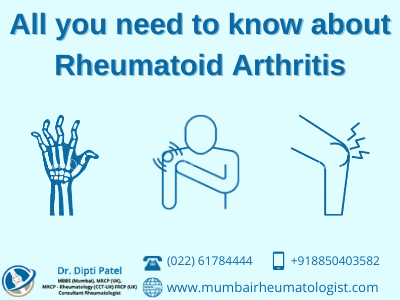 24 Mar 2021
24 Mar 2021
Rheumatoid Arthritis is an autoimmune disorder that hampers your body systems, including skin, eyes, lungs, heart, and blood vessels along with your joints. Rheumatoid Arthritis occurs when your immune system falsely attacks your own body’s tissues.
Rheumatoid Arthritis, unlike osteoarthritis, affects the lining of the joints, causing a chronic inflammation that can gradually lead to bone deterioration and joint deformity.
The following are some of the signs and symptoms of Rheumatoid Arthritis:
- Joints that are tender, warm, and swollen
- Morning stiffness and inactivity are the most common causes of joint stiffness.
- Fever, weakness, and a lack of appetite
- Smaller joints, such as the joints that bind your fingers to your hands and your toes to your feet, are often the first to be affected by early Rheumatoid Arthritis.
- Wrists, knees, ankles, elbows, hips, and shoulders are often affected as the disease progresses. Symptoms manifest in the same joints on both sides of the body in the majority of cases.
Around 40% of people with Rheumatoid Arthritis may have signs and symptoms that aren’t linked to their joints. Many nonjoint structures may be affected by Rheumatoid Arthritis, including:
- Skin
- Eyes
- Lungs
- Heart
- Kidneys
- Salivary glands
- Nerve tissue
- Bone marrow
- Blood vessels
The severity of Rheumatoid Arthritis symptoms can vary, and they can come and go. Flares, or periods of elevated disease activity, alternate with remissions, or periods where the swelling and pain diminish or disappear. Rheumatoid Arthritis causes joints to bend and move out of place over time.
Treatments
Rheumatoid arthritis has no proven cure. However, drug studies suggest that early treatment with disease-modifying antirheumatic drugs (DMARDs) improves the probability of symptom recovery (DMARDs).
Medicines
Your doctor’s prescription advice will be focused on the severity of your symptoms and the amount of time you’ve had Rheumatoid Arthritis.
Therapy
Your doctor can refer you to a physical or occupational therapist who can teach you workouts to maintain joint flexibility. The therapist can also recommend new ways to complete everyday activities that are less taxing on your joints. You would want to pick up an object with your forearms, for example.
Surgery
If medicines do not prevent or delay joint damage, you and your doctor can choose to have surgery to fix the damaged joints. Surgery can be able to help you recover the ability to move your joint. It can also help with pain and work.
